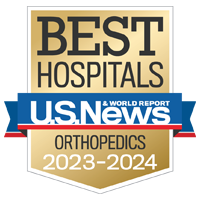Ulnar Collateral Ligament (UCL) Injury

Overview
An ulnar collateral ligament (UCL) injury is a common occurrence in athletes whose sports demand repetitive or forceful elbow movements, such as tennis, golf and baseball. The UCL is a tough band of tissue in the inner arm that connects the forearm and upper arm bones and supports the elbow in throwing or swinging. But too much force or repetition can overstress this ligament, leading to inflammation or, in severe cases, a tear.
Our approach to care
UCSF offers comprehensive, cutting-edge care for athletes of all ages and playing at all levels. We are fully equipped to diagnose and treat injuries in our state-of-the art facilities and with our team of sports medicine doctors, orthopedic surgeons, physical therapists and athletic trainers. These experts work together to tailor a treatment plan that will meet each patient's needs and goals.
Awards & recognition
-

One of the nation's best for orthopedic care
-

Among the top hospitals in the nation
Signs & symptoms
The first sign of a UCL injury is pain on the inside of the elbow, worsened by activity. Repeated stress and injury can eventually lead to a full tearing of the ligament. If the ligament tears, you may feel a pop and be unable to continue.
Other symptoms include:
- Swelling and bruising (24 hours after injury) on the inner elbow and upper arm
- Inability to throw at full speed or loss of ball control
- Stiffness in the elbow or inability to straighten it
- Numbness or tingling in the hand and the ring and little fingers
- A clumsy or weak grip
Diagnosis
Your doctor will do a physical exam to check your elbow's range of motion and stability and to precisely locate the pain. But because ligament injuries often have the same symptoms and appearance as tendon damage, the doctor may also order an MRI. This imaging test provides clear pictures of soft tissue, used to confirm that you have a UCL injury and determine its severity.
Treatment
For less severe injuries, patients usually get better with rest, icing the area and taking over-the-counter pain medication (acetaminophen or ibuprofen). Once the injury starts to heal, physical therapy can help restore strength and flexibility. Athletes may be referred to a physical therapist who specializes in teaching safer throwing techniques. If this treatment plan is successful, you may be able to return to playing your sport in six to nine weeks.
If pain and weakness persist because the UCL is torn, we may offer you an injection of platelet-rich plasma (PRP), a therapy that uses your own platelets to stimulate healing. For this procedure, we draw a small amount of blood, separate the platelets from other blood cells using a centrifuge, and then inject the PRP into the injured area.
Another option for a torn UCL is surgery. This may mean repairing the ligament by suturing the tear together or, if that's not possible, reconstructing the UCL, using either tissue taken from a cadaver donor or one of your own tendons. The grafted tissue serves as a scaffold on which a new ligament will grow. This procedure is known as "Tommy John surgery," named for major-league pitcher Tommy John, who had the first successful UCL reconstruction in 1974.
Both procedures are open surgeries (meaning they involve the traditional approach of cutting through skin and tissue to reach the injured area), but you're able to go home the same day. You'll be in a brace for several weeks and follow a slow, progressive rehabilitation program. Overhead motions and throwing may be possible after three to six months, but regaining your full throwing or swinging ability will likely take six to nine months.
UCSF Health medical specialists have reviewed this information. It is for educational purposes only and is not intended to replace the advice of your doctor or other health care provider. We encourage you to discuss any questions or concerns you may have with your provider.





